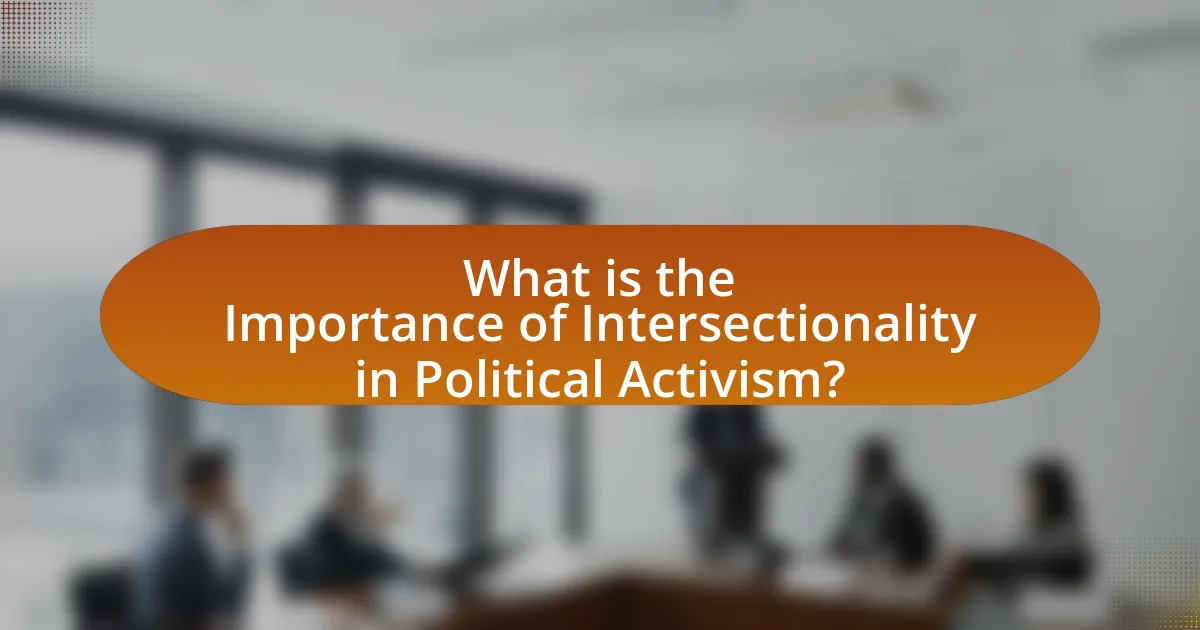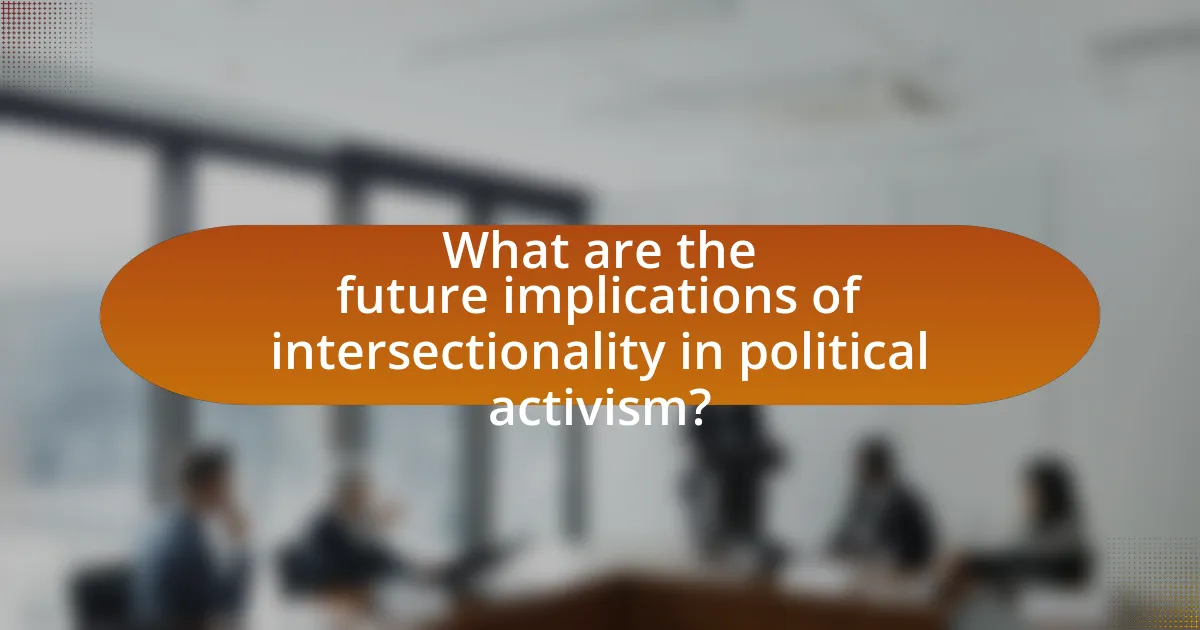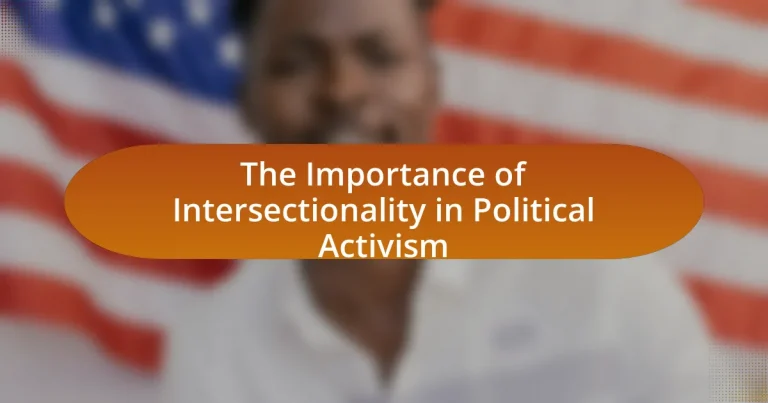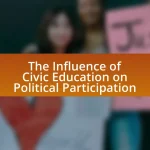The article focuses on the significance of intersectionality in political activism, emphasizing how it recognizes the interconnected nature of social identities such as race, gender, class, and sexuality. It discusses the importance of incorporating intersectional perspectives to create inclusive and effective advocacy strategies, as demonstrated by movements like Black Lives Matter and the Combahee River Collective. Key principles of intersectionality, its role in addressing systemic inequalities, and the challenges activists face when integrating this framework into their work are also examined. Additionally, the article highlights best practices for implementing intersectionality in campaigns and the future implications for political activism.

What is the Importance of Intersectionality in Political Activism?
Intersectionality is crucial in political activism because it recognizes and addresses the interconnected nature of social categorizations such as race, gender, class, and sexuality, which can lead to overlapping systems of discrimination or disadvantage. This framework allows activists to understand how various forms of inequality interact, ensuring that movements are inclusive and representative of diverse experiences. For instance, the Combahee River Collective, a group of Black feminists, articulated in 1977 that their activism must address the unique struggles faced by Black women, highlighting that traditional feminist movements often overlooked these intersections. By incorporating intersectionality, political activism can create more effective strategies that resonate with a broader audience and foster solidarity among marginalized groups.
How does intersectionality influence political activism?
Intersectionality influences political activism by highlighting the interconnected nature of social categorizations such as race, gender, and class, which create overlapping systems of discrimination or disadvantage. This framework allows activists to understand and address the unique challenges faced by individuals at the intersections of these identities, leading to more inclusive and effective advocacy strategies. For example, the Black Lives Matter movement incorporates intersectional perspectives by addressing not only racial injustice but also issues related to gender and sexuality, thereby broadening its appeal and impact. Research by Crenshaw (1989) emphasizes that failing to consider intersectionality can lead to the marginalization of certain groups within social movements, ultimately weakening the overall effectiveness of political activism.
What are the key principles of intersectionality in this context?
The key principles of intersectionality in the context of political activism include the recognition that individuals experience overlapping social identities, which can lead to unique forms of discrimination and privilege. This framework emphasizes that social categories such as race, gender, class, and sexuality do not exist independently but interact to shape individual experiences and systemic inequalities. For instance, a Black woman may face both racial and gender discrimination, which cannot be fully understood by examining race or gender in isolation. This principle is supported by Kimberlé Crenshaw’s foundational work on intersectionality, which highlights how legal and social systems often fail to address the complexities of individuals’ lived experiences, thereby perpetuating inequality.
How does intersectionality address systemic inequalities?
Intersectionality addresses systemic inequalities by recognizing that individuals experience multiple, overlapping identities that contribute to unique forms of discrimination and privilege. This framework highlights how social categories such as race, gender, class, and sexuality intersect, leading to compounded disadvantages for marginalized groups. For example, Black women face both racial and gender discrimination, which cannot be fully understood by examining either identity in isolation. Research by Kimberlé Crenshaw, who coined the term “intersectionality,” illustrates that legal and social systems often fail to address these complexities, resulting in inadequate protections and resources for those at the intersections of multiple marginalized identities. By advocating for policies that consider these intersecting factors, intersectionality seeks to create more equitable systems that address the root causes of inequality.
Why is intersectionality crucial for effective political movements?
Intersectionality is crucial for effective political movements because it recognizes and addresses the interconnected nature of social categorizations such as race, gender, and class, which can lead to overlapping systems of discrimination or disadvantage. By incorporating intersectional perspectives, political movements can create more inclusive strategies that resonate with diverse populations, ensuring that the unique experiences and needs of marginalized groups are acknowledged and addressed. For instance, the Black Lives Matter movement emphasizes the importance of intersectionality by advocating for the rights of Black women and LGBTQ+ individuals, highlighting that their struggles are distinct yet interconnected. This approach not only broadens the coalition of support but also enhances the movement’s effectiveness by fostering solidarity among various groups, ultimately leading to more comprehensive policy changes and social justice outcomes.
What role does intersectionality play in coalition-building?
Intersectionality plays a crucial role in coalition-building by ensuring that diverse identities and experiences are recognized and addressed within collective movements. This approach fosters inclusivity, allowing coalitions to unite individuals from various backgrounds, such as race, gender, sexuality, and class, thereby enhancing the effectiveness of advocacy efforts. Research by Crenshaw (1989) highlights that understanding the interconnected nature of social categorizations helps to identify and combat systemic inequalities, making coalitions more representative and responsive to the needs of marginalized groups. By integrating intersectional perspectives, coalitions can develop strategies that are more equitable and impactful, ultimately leading to stronger social movements.
How does intersectionality enhance representation in activism?
Intersectionality enhances representation in activism by recognizing and addressing the multiple, overlapping identities individuals hold, such as race, gender, sexuality, and class. This framework allows activists to understand how these identities intersect to create unique experiences of oppression and privilege, leading to more inclusive and effective advocacy. For instance, the 2015 report by the American Psychological Association highlighted that intersectional approaches in activism can lead to better policy outcomes by ensuring that the voices of marginalized groups are heard and considered. By incorporating diverse perspectives, intersectionality fosters solidarity among various social movements, ultimately strengthening the collective impact of activism.

What challenges arise when integrating intersectionality into political activism?
Integrating intersectionality into political activism presents challenges such as the complexity of addressing multiple, overlapping identities and the potential for fragmentation within movements. Activists often struggle to create inclusive spaces that adequately represent diverse experiences, which can lead to tensions among different groups. For instance, a study by Crenshaw (1989) highlights how traditional feminist and anti-racist movements frequently overlook the unique struggles faced by women of color, illustrating the difficulty in achieving a unified agenda that encompasses all perspectives. Additionally, resource allocation can become contentious, as groups may compete for attention and funding, complicating coalition-building efforts. These challenges necessitate ongoing dialogue and a commitment to understanding the nuanced realities of marginalized communities within political activism.
What are common misconceptions about intersectionality in activism?
Common misconceptions about intersectionality in activism include the belief that it solely focuses on identity politics and that it creates divisions among marginalized groups. Intersectionality, as defined by Kimberlé Crenshaw, emphasizes how various social identities, such as race, gender, and class, intersect to create unique experiences of oppression. This framework does not merely categorize individuals but seeks to understand the complexities of their experiences, promoting solidarity rather than division. Additionally, some activists mistakenly think that intersectionality dilutes the focus on specific issues; however, it actually enriches activism by highlighting how different forms of discrimination are interconnected, as evidenced by studies showing that addressing multiple identities can lead to more effective advocacy outcomes.
How can activists overcome these misconceptions?
Activists can overcome misconceptions by actively educating themselves and their communities about intersectionality. This involves sharing accurate information that highlights how various social identities, such as race, gender, and class, intersect to create unique experiences of oppression. Research by Crenshaw (1989) emphasizes that understanding these intersections is crucial for effective advocacy, as it reveals the complexity of social issues. By hosting workshops, creating informative content, and engaging in dialogue, activists can dismantle stereotypes and foster a more inclusive understanding of activism.
What are the risks of ignoring intersectionality in political movements?
Ignoring intersectionality in political movements risks marginalizing the voices and experiences of individuals who belong to multiple oppressed groups. This oversight can lead to policies and actions that fail to address the unique challenges faced by these individuals, resulting in ineffective advocacy and perpetuation of systemic inequalities. For instance, the Women’s March in 2017 faced criticism for not adequately representing the experiences of women of color, LGBTQ+ individuals, and those from lower socioeconomic backgrounds, which highlighted the necessity of an intersectional approach to ensure comprehensive representation and support. Without intersectionality, political movements may inadvertently reinforce existing power dynamics, alienate potential allies, and ultimately weaken their overall impact.
How can intersectionality be effectively implemented in political strategies?
Intersectionality can be effectively implemented in political strategies by integrating diverse perspectives and experiences into policy-making processes. This approach ensures that the needs of marginalized groups, such as women of color, LGBTQ+ individuals, and people with disabilities, are considered in legislative agendas. For instance, the implementation of intersectional analysis in the 2019 U.S. House of Representatives’ resolution on racial justice highlighted the unique challenges faced by different communities, leading to more comprehensive and inclusive policies. By utilizing data disaggregated by race, gender, and socioeconomic status, political strategies can address systemic inequalities more effectively, as evidenced by the success of intersectional frameworks in movements like Black Lives Matter, which advocate for the rights of various intersecting identities.
What best practices exist for incorporating intersectionality in campaigns?
Incorporating intersectionality in campaigns involves recognizing and addressing the diverse identities and experiences of individuals affected by social issues. Best practices include conducting thorough research to understand the specific needs of various marginalized groups, ensuring representation of these groups in campaign planning and execution, and using inclusive language that resonates with different communities. For instance, campaigns that have successfully integrated intersectionality, such as the Women’s March, highlight the importance of amplifying voices from various backgrounds, including race, gender, and socioeconomic status, to create a more comprehensive and effective advocacy strategy. This approach not only fosters inclusivity but also enhances the campaign’s credibility and reach, ultimately leading to more impactful outcomes.
How can activists measure the impact of intersectional approaches?
Activists can measure the impact of intersectional approaches by utilizing qualitative and quantitative research methods to assess changes in social dynamics, policy outcomes, and community engagement. For instance, surveys and interviews can capture the experiences of marginalized groups, revealing how intersectional strategies address their unique challenges. Additionally, analyzing data on policy changes, such as the implementation of inclusive legislation, provides concrete evidence of the effectiveness of intersectional activism. Studies, like the one conducted by Crenshaw in 1989, highlight the necessity of considering multiple identities in understanding systemic oppression, reinforcing the importance of intersectional frameworks in activism.

What are the future implications of intersectionality in political activism?
The future implications of intersectionality in political activism include a more inclusive and nuanced approach to advocacy that addresses the diverse experiences of marginalized groups. As political movements increasingly recognize the interconnectedness of social identities, activists will likely prioritize coalition-building among various groups, leading to broader support for policies that reflect the complexities of systemic oppression. Research indicates that intersectional frameworks can enhance the effectiveness of activism by fostering solidarity and understanding among different communities, as seen in movements like Black Lives Matter, which emphasizes the importance of race, gender, and class in its advocacy efforts. This shift towards intersectionality is expected to reshape political discourse, encouraging more comprehensive solutions to social justice issues.
How is the concept of intersectionality evolving in contemporary activism?
The concept of intersectionality is evolving in contemporary activism by increasingly emphasizing the interconnectedness of various social identities and systemic inequalities. Activists are now recognizing that issues such as race, gender, sexuality, and class do not exist in isolation but rather intersect to create unique experiences of oppression and privilege. This evolution is evidenced by the rise of movements like Black Lives Matter and the Women’s March, which explicitly incorporate intersectional frameworks to address the diverse needs of marginalized communities. Research from the American Psychological Association highlights that intersectional approaches lead to more effective advocacy by acknowledging the complexity of individuals’ identities and experiences.
What emerging trends are shaping intersectional political activism?
Emerging trends shaping intersectional political activism include the rise of digital platforms for grassroots organizing, increased collaboration among diverse social movements, and a focus on climate justice as a critical intersectional issue. Digital platforms, such as social media, enable activists to mobilize quickly and reach broader audiences, exemplified by movements like Black Lives Matter and the Women’s March, which leverage online engagement to amplify their messages. Collaboration among various social movements, such as those advocating for racial justice, LGBTQ+ rights, and economic equity, fosters a more inclusive approach to activism, as seen in coalitions formed during protests and advocacy campaigns. Additionally, the emphasis on climate justice highlights the interconnectedness of environmental issues with social inequalities, as activists increasingly recognize that marginalized communities often bear the brunt of climate change impacts. This trend is supported by research from the United Nations, which indicates that climate change disproportionately affects vulnerable populations, reinforcing the need for intersectional approaches in political activism.
How can future activists prepare for challenges related to intersectionality?
Future activists can prepare for challenges related to intersectionality by educating themselves on the diverse identities and experiences that intersect within social justice movements. This preparation involves understanding how factors such as race, gender, sexuality, and class interact to create unique forms of oppression. Research indicates that movements that embrace intersectionality, such as the Black Lives Matter movement, have been more effective in addressing systemic inequalities because they recognize the complexity of individuals’ experiences (Crenshaw, 1989). By actively engaging in dialogues, attending workshops, and collaborating with marginalized communities, activists can develop a nuanced perspective that enhances their advocacy efforts and fosters inclusivity.
What practical steps can activists take to embrace intersectionality?
Activists can embrace intersectionality by actively educating themselves and their communities about the diverse identities and experiences that shape social issues. This involves engaging in training sessions, workshops, and discussions that highlight how race, gender, sexuality, class, and other factors intersect to create unique challenges for different groups. For instance, the 2017 Women’s March emphasized intersectionality by including voices from various marginalized communities, demonstrating that collective action must address multiple forms of oppression. Additionally, activists should collaborate with organizations that represent diverse populations, ensuring that their strategies and campaigns reflect the needs of all affected groups. This approach not only broadens the movement’s impact but also fosters solidarity among various social justice efforts.
How can individuals educate themselves about intersectionality?
Individuals can educate themselves about intersectionality by engaging with foundational texts, attending workshops, and participating in discussions that explore the interconnected nature of social categorizations. Foundational texts such as “Mapping the Margins” by Kimberlé Crenshaw provide critical insights into how race, gender, and class intersect to shape individual experiences. Workshops and seminars often hosted by universities or community organizations offer practical applications of intersectional theory, allowing participants to analyze real-world issues through an intersectional lens. Additionally, joining online forums or local activist groups can facilitate discussions that deepen understanding and promote awareness of intersectionality’s relevance in political activism.
What resources are available for activists to learn about intersectionality?
Activists can access a variety of resources to learn about intersectionality, including books, online courses, and academic articles. Notable books such as “Intersectionality” by Kimberlé Crenshaw and “Sister Outsider” by Audre Lorde provide foundational knowledge on the subject. Online platforms like Coursera and edX offer courses on social justice and intersectionality, often featuring contributions from leading scholars in the field. Additionally, academic journals such as “Signs: Journal of Women in Culture and Society” publish peer-reviewed articles that explore intersectional theory and its applications in activism. These resources collectively enhance understanding and application of intersectionality in political activism.


